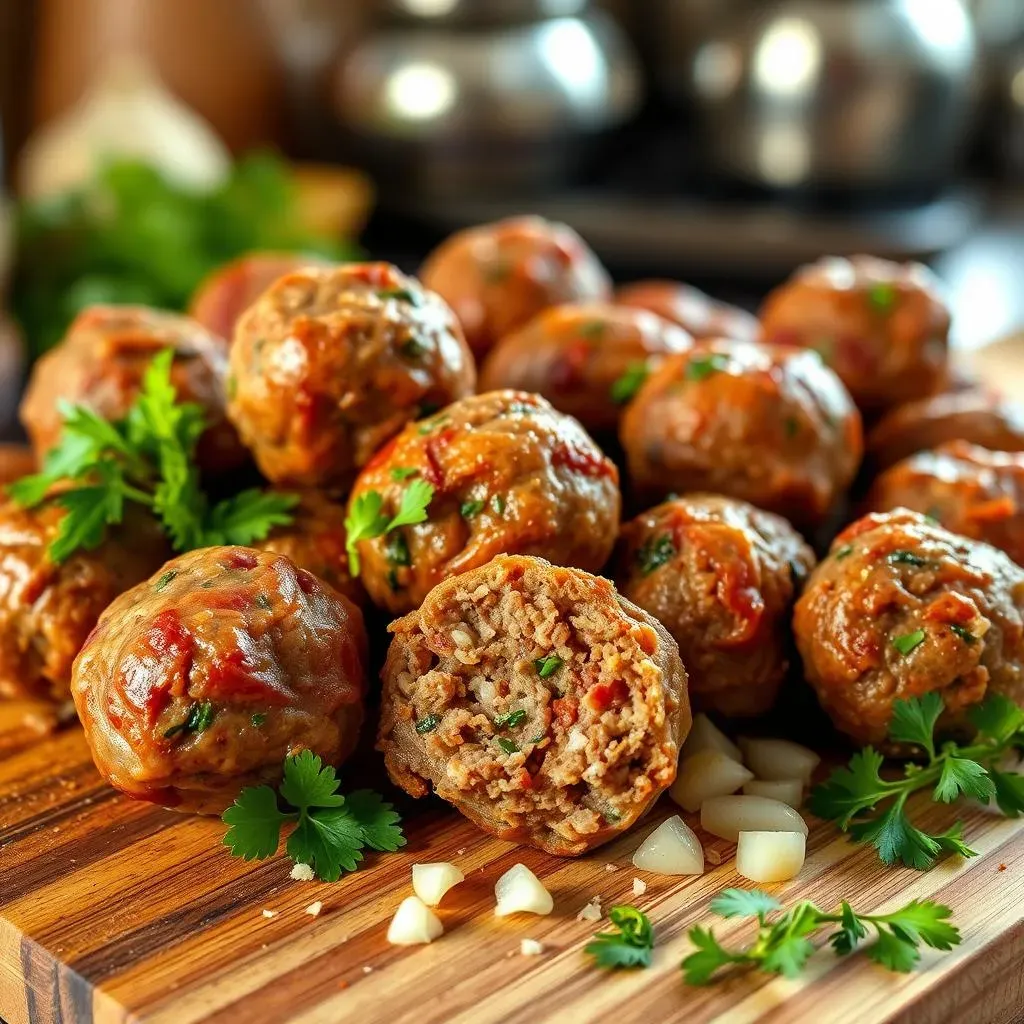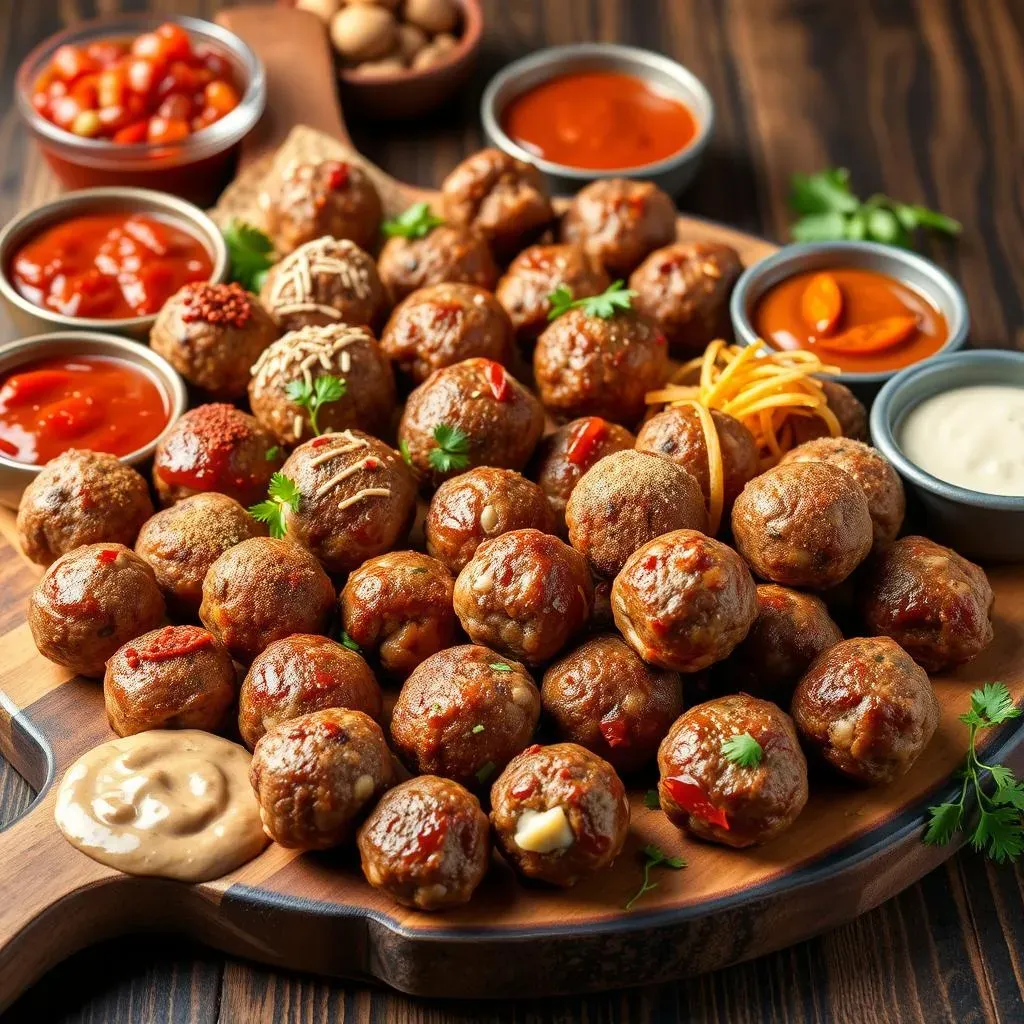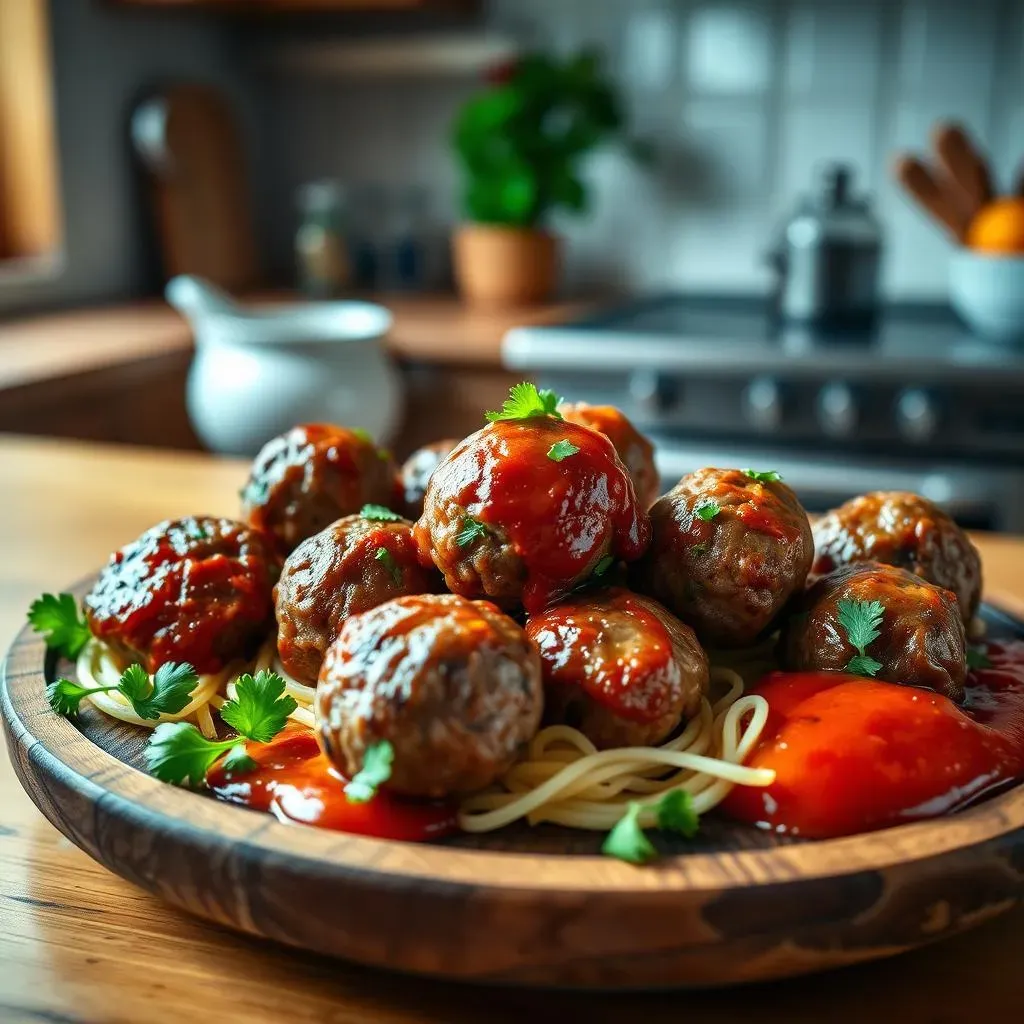Table of Contents
Are you ready to elevate your dinner game? Then prepare yourself for a culinary adventure into the world of sausage and beef meatballs! This article isn't just another recipe; it's your comprehensive guide to crafting the perfect sausage and beef meatballs recipe, from mastering the basic technique to exploring exciting variations. We'll walk you through a step-by-step process, ensuring even novice cooks can achieve restaurant-quality results. Get ready to discover the secrets to juicy, flavorful meatballs that will impress your family and friends. We'll cover everything from the ideal meat blend and seasoning techniques to the best cooking methods for achieving perfectly browned exteriors and tender, succulent interiors. But that's not all! We'll also delve into creative variations on the classic sausage and beef meatballs recipe, offering inspiration for customizing your dish to suit your taste preferences. Finally, we'll equip you with essential tips and tricks to ensure your sausage and beef meatballs are always a resounding success. So, gather your ingredients, sharpen your knives, and let's embark on this delicious journey together! Prepare to be amazed by how simple it is to create extraordinary sausage and beef meatballs using our expert advice. Get ready to become a meatball master!
The Best Sausage and Beef Meatball Recipe: A StepbyStep Guide

The Best Sausage and Beef Meatball Recipe: A StepbyStep Guide
Gathering Your Ingredients
First, let's talk about the star players: the meats! A classic ratio is 2 parts ground beef to 1 part Italian sausage. I prefer a leaner ground beef (around 85% lean) for a healthier, less greasy meatball. But feel free to experiment – even extra-lean works great if you add a little extra breadcrumb to help bind it all together. For the sausage, I recommend removing it from its casing for even distribution throughout the mixture. Next up, the binder – breadcrumbs are essential! They absorb moisture and help create a tender, not tough, meatball. I usually opt for plain breadcrumbs, but panko or Italian-seasoned breadcrumbs also work well. Finally, don’t forget the aromatics! Finely minced garlic and onion add a ton of flavor. A little fresh parsley or basil also makes them sing!
Now, let's talk spices! Salt and pepper are non-negotiable. Beyond that, it's time to get creative. A pinch of red pepper flakes adds a subtle kick. Dried oregano and basil are great choices for a classic Italian flavor profile. If you want to explore different flavor profiles, try adding a teaspoon of paprika for a smoky taste or a dash of nutmeg for warmth. Once you've got your seasonings nailed down, you need an egg or two to help the meatballs bind nicely. This prevents them from falling apart and makes them extra juicy. And finally, a splash of milk or water can help create a perfectly moist mixture. Don't be afraid to adjust the liquid if the mixture seems too dry. For a richer flavor, try using some grated Parmesan cheese!
Ingredient | Quantity | Notes |
|---|---|---|
Ground Beef (85% lean) | 1 lb | Adjust leanness to your preference |
Italian Sausage (removed from casing) | 0.5 lb | Mild or spicy, your choice! |
Breadcrumbs | 1/2 cup | Plain, panko, or Italian seasoned |
Minced Garlic | 2 cloves | Fresh is best! |
Minced Onion | 1/4 cup | Adds sweetness and depth |
Mixing and Shaping Your Meatballs
In a large bowl, gently combine all your ingredients. Avoid overmixing, as this can make the meatballs tough. Just mix until everything is evenly distributed. The mixture should be moist but not soggy. If it’s too dry, add a tablespoon of milk or water at a time. If it’s too wet, add more breadcrumbs, a spoonful at a time, until you achieve the right consistency. Once you’ve got the perfect mixture, it’s time to shape those meatballs! I like to use a small cookie scoop or a tablespoon to ensure that they're all roughly the same size. This ensures even cooking. Roll each scoop into a ball, using your hands. Gently roll them to make them smooth and round. Don’t squish them too hard, as this can make them dense.
You can bake, broil, or pan-fry your meatballs. For oven-baked meatballs, arrange them on a baking sheet lined with parchment paper, leaving a little space between them. For broiling, use a wire rack over a baking sheet to allow for even browning. If you prefer pan-frying, heat a little olive oil in a large skillet over medium heat. Fry the meatballs in batches, turning occasionally, until they are golden brown on all sides. No matter which method you choose, make sure to cook them until they reach an internal temperature of 165°F (74°C) to ensure they're fully cooked. For extra flavor, you can simmer the cooked meatballs in your favorite sauce for 15-20 minutes before serving. For extra-crispy meatballs, try our .
- Gently combine ingredients.
- Use a cookie scoop for uniform size.
- Roll into smooth balls.
- Bake, broil, or pan-fry until cooked through.
- Simmer in sauce for extra flavor (optional).
Cooking and Serving Your Masterpiece
Now comes the fun part – cooking your meatballs! You have a few options here: baking, broiling, or pan-frying. Baking is the easiest method; simply place your meatballs on a baking sheet lined with parchment paper and bake at 375°F (190°C) for about 20-25 minutes, or until cooked through. Broiling gives them a nice char; arrange them on a wire rack set over a baking sheet and broil for about 10-12 minutes, flipping halfway through. Pan-frying adds a delicious crispy exterior; heat some olive oil in a large skillet over medium heat and cook the meatballs in batches, turning occasionally, until golden brown.
Once your meatballs are cooked, the possibilities are endless! Serve them over your favorite pasta with marinara sauce, make delicious meatball subs, add them to a hearty soup, or even use them as a topping for pizza. Don't forget to let your creativity guide you! For inspiration, check out our post on , which explores different flavor profiles and cooking methods. No matter how you choose to serve them, your homemade sausage and beef meatballs are sure to be a crowd-pleaser. Remember, the key is to have fun and experiment with different flavors and techniques to find what works best for you!
Variations on the Classic Sausage and Beef Meatball Recipe

Variations on the Classic Sausage and Beef Meatball Recipe
Spice It Up!
Let's kick things up a notch! Why stick to plain old Italian seasoning when you can unleash a world of flavor? For a fiery twist, add a generous pinch of red pepper flakes to your meatball mixture. Or, for a smoky depth, try incorporating a teaspoon of smoked paprika. If you're feeling adventurous, a dash of chipotle powder adds a delightful smoky heat. Remember to adjust the amount of spice according to your preference; start small and add more gradually until you achieve your desired level of spiciness. Don't be afraid to experiment! A little goes a long way, and you can always add more, but you can't take it away. For some extra inspiration, check out our for some seriously flavorful ideas.
Beyond the heat, you can also add other exciting spices and herbs. A touch of nutmeg provides a warm, comforting note, while a sprinkle of fennel seeds adds a subtle licorice-like flavor. Fresh herbs, such as finely chopped rosemary or thyme, can also elevate your meatballs to another level. Consider the existing flavors in your meatball mixture and the sauce you plan to serve it with. For instance, if you are using a tomato-based sauce, oregano and basil are classic choices. However, if you're serving your meatballs with a creamy sauce, you may want to opt for more subtle herbs like parsley or chives. Want to discover more creative flavor combinations? Browse our for more ideas!
- Red pepper flakes for heat
- Smoked paprika for smoky flavor
- Chipotle powder for smoky heat
- Nutmeg for warmth
- Fennel seeds for licorice notes
- Fresh rosemary or thyme
Global Meatball Fusion
Why limit yourself to Italian flavors? The beauty of meatballs lies in their versatility. Let's explore some exciting global twists! For a taste of Asia, incorporate soy sauce, ginger, and garlic into your meatball mixture. Add a touch of sesame oil for an extra layer of flavor and aroma. Serve these Asian-inspired meatballs with a sweet and sour sauce or a vibrant peanut sauce. For a taste of Mexico, try adding cumin, chili powder, and a touch of oregano. Serve these Mexican-style meatballs with a zesty salsa or a creamy avocado sauce. Don't be shy about experimenting with different sauces and accompaniments to create a unique flavor profile that suits your taste.
Thinking outside the box can lead to some incredibly unique and delicious meatball creations. For example, you can add crumbled feta cheese and sun-dried tomatoes to your mixture for a Mediterranean-inspired twist. Or, for a taste of the South, you might incorporate chopped pecans and a touch of bourbon into your meatballs. The possibilities are truly endless! Remember to consider the textures and flavors of the additional ingredients you add and how they will complement the overall taste of your meatballs. For a richer flavor, you might consider adding some finely chopped mushrooms or bell peppers to your mixture. No matter what global adventure you choose, your taste buds are in for a treat! To find more inspiration, check out our article on for more flavor combinations.
Region | Flavor Profile | Suggested Sauce |
|---|---|---|
Asian | Soy sauce, ginger, garlic, sesame oil | Sweet and sour, peanut |
Mexican | Cumin, chili powder, oregano | Salsa, avocado cream |
Mediterranean | Feta cheese, sun-dried tomatoes | Tzatziki, lemon-herb |
Meatball Makeovers: Beyond the Classic
Let's explore some exciting variations on the classic form! Instead of perfectly round meatballs, try making smaller meatballs, perfect for appetizers or adding to soups and stews. Or, go big and bold with giant meatballs – ideal for serving as a main course. You can also get creative with the shape; use a meatball maker for perfectly uniform spheres, or simply roll them into oblong shapes for a rustic look. The possibilities are endless! And don't forget about the internal structure of your meatballs; consider adding finely diced vegetables like carrots, zucchini, or bell peppers to your mixture for added texture and nutrients. This is a great way to sneak in extra veggies while creating delicious and hearty meatballs.
Another fun way to change things up is to stuff your meatballs! Try adding a center of mozzarella cheese, a spicy chorizo sausage, or even a savory filling of herbs and breadcrumbs. The possibilities are limitless, and the results are guaranteed to be delicious. Consider the flavors of your stuffing and how they will complement the overall taste of your meatballs. You can also experiment with different cooking methods to achieve different textures. For example, baking your meatballs will result in a tender and moist interior, while pan-frying will create a crispy exterior. To learn more about different cooking methods and meatball variations, check out our for some insider tips and tricks!
Tips and Tricks for Perfect Sausage and Beef Meatballs Every Time

Tips and Tricks for Perfect Sausage and Beef Meatballs Every Time
Don't Overwork Your Meat
Gentle handling is key! Overmixing your meatball mixture leads to tough, dense meatballs. Think of it like kneading bread – too much work results in a chewy loaf. Instead, gently combine your ingredients until just mixed. A few lumps are okay; they'll disappear during cooking. Aim for a moist but not wet mixture. If it's too dry, add a splash of milk or water; if it's too wet, add a bit more breadcrumbs. This delicate approach ensures tender, juicy meatballs every time. For more detailed instructions, check out our for some extra tips and tricks.
Another crucial tip is to let your meatball mixture rest for about 15-20 minutes before shaping. This allows the flavors to meld and the breadcrumbs to absorb moisture, resulting in a more cohesive and flavorful meatball. While the mixture rests, you can prepare your cooking surface, preheat your oven, or chop any additional ingredients you may need. Once the mixture has rested, your meatballs will be easier to shape and will hold their form better during cooking. Need some more make-ahead ideas? Check out our guide.
- Gently combine ingredients.
- Avoid overmixing.
- Let the mixture rest for 15-20 minutes.
Mastering the Meatball Cook
Cooking your meatballs to perfection is an art! For even cooking and browning, make sure your meatballs are roughly the same size. Using a cookie scoop or a tablespoon helps achieve consistency. Overcrowding the pan or baking sheet leads to uneven cooking and steaming instead of browning. Give your meatballs some space! This allows for good air circulation, resulting in beautifully browned exteriors and perfectly cooked interiors. For baking, aim for a temperature of 375°F (190°C) and cook until the internal temperature reaches 165°F (74°C). This ensures that your meatballs are fully cooked and safe to eat. For some alternative cooking methods, check out our .
Don't forget the sauce! Simmering your cooked meatballs in your favorite sauce for 15-20 minutes adds incredible depth of flavor and keeps them moist. This is especially helpful if you're using leaner ground beef. For a richer sauce, consider adding some finely diced vegetables, herbs, or spices. You can also adjust the consistency of your sauce by adding a little water or tomato paste. The simmering process also helps to soften the meatballs, resulting in a more tender and flavorful final product. Looking for some delicious sauce ideas? Explore our for more inspiration!
Cooking Method | Temperature (°F) | Cook Time (approx.) |
|---|---|---|
Baking | 375 | 20-25 minutes |
Broiling | High | 10-12 minutes |
Pan-frying | Medium | 15-20 minutes |